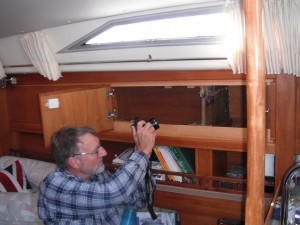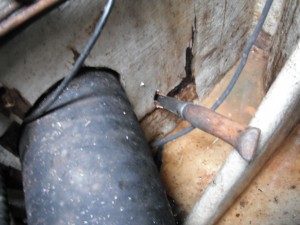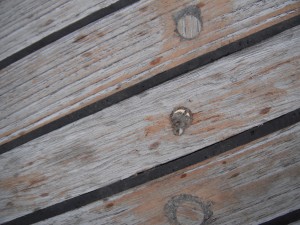By Aidan Tuckett of Brighton Marine Surveys
In this article we’re going to cover what you might look for when buying a classic GRP or glassfibre yacht.
This is relatively easy territory for surveyors compared to wood or steel. Most of a survey report on a wooden boat might be used to describe the problems besetting the hull, leaving the engine, rig and systems as peripheral matters whereas a GRP yacht survey can usually cover the mouldings in a page.
There are also advantages in that early GRP boats were built when the material wasn’t entirely trusted and when oil, the main component of polyester resin, was relatively cheap. Consequently, up to the 1970s boat builders often moulded hulls far thicker than they needed to be. As a result problems tend to be more cosmetic than structural and usually ones that will be apparent after 30 years or more.
So assuming you can get past Francis Herreshoff’s description of GRP as frozen snot, if an old GRP hull is sound then it will probably stay that way.
The main difference compared to wood or steel is that GRP is made as the boat is moulded, not selected from a stockpile, so the quality of the finished product will depend on how good the laminators are. The material is essentially fine glass strands set within a cured resin and coated with a relatively impervious gel coat or flow coat. Moulding flaws are not always obvious and best left to a surveyor who can inspect and hammer sound for voids or delamination and use a moisture meter to check for potential blistering or other damage that might be evident from water ingress. But that still leaves plenty of things you can look for before you take the plunge and pay a deposit.
If you see the boat out of the water one of the first things you might be concerned about is osmotic blistering. Don’t be. It is virtually unknown for a heavily laid up GRP moulding to be structurally weakened by osmosis. Blistering is caused by flaws in the gel coat and laminate whereby minute holes on the surface will allow water into small pockets of uncured resin within the lay up where it can form an acidic solution. This can lift the gel coat away from the laminate as a result of osmotic pressure.
It might be unsightly but it is very unlikely the underlying laminate will absorb water or break down to the extent the boat’s integrity is compromised, certainly not within the timeframe everything else on board will last for, and that probably includes the owners. If a smooth bottom is really important to you then osmosis can be fixed, but at a cost unlikely to make economic sense in an elderly boat with dated equipment. The latest techniques involve peeling both the gelcoat and outer layers of the laminate off, re-laminating these layers using more moisture resistant vinylester resins and coating with epoxy based barrier coats. Just peeling away the gel coat and then drying the hull over many weeks before recoating is not done so much now because of the time and space it takes in a busy yard.
Incidentally epoxy barrier coats are fine for preserving an already dry hull but not much use to prevent a blistered hull from getting worse.
You should also beware of hulls with steps around the waterline or skin fittings where the gelcoat has been removed and replaced with a thin layer of epoxy – this will not do the job.
Whilst you are outside, also consider things that can go wrong as a result of careless use. This might include a heavy grounding or yard accident that weakens the keel to hull fastenings and shows up as cracks along the line of the joint. A well-raced boat may collect a few bumps so check the perimeter of the hull for damaged rubbing strakes or cappings, or for large radiating circular crazing, or changes in gel coat colour that show poorly made repairs. These are all fixable but should be reflected in the price you pay. Early GRP hulls were usually stiffened with plywood bulkheads and floors, and with laminated stringers. Internal mouldings were lightweight affairs to make fitting out easier, not the structural members they are nowadays. Decks were often made with a sandwich construction using a balsa core between two thinner layers of laminate.
So keeping the presence of all this wood in mind, look for signs of deterioration beneath GRP surfaces. On deck, unusual amounts of give and light cracking sounds as you walk about might show where a cored construction has
separated. Crazing around high load areas such as the foredeck, or depressions around a deck stepped mast base can also show problems.
Be particularly wary of teak plank overlays, especially if they are fastened by screws driven into the core material and have worn to the extent the screw heads are visible. If the deck has any give from a failed core, this has to be repaired and renewing a teak overlay can easily cost more than the boat is worth.
Down below, look for where water may have been trapped and soaked into the end grain of plywood bulkheads – again if these structural members are weakened, repair costs will be significant. Chain plates are often bolted to plywood knees laminated into the hull which can rot where water gets through deck plates. Leaks from hatches and windows can damage wood linings that are often lightly made and can be expensive to restore to a reasonable standard.
Main photo: a Mark 1 GRP Trintella. She looks really nice. And boats like this can be a bargain.
Editor’s note: While doing your own preliminary survey is a good idea and should help you to make a reasonable estimate of her condition it is not a substitute for a proper survey.








